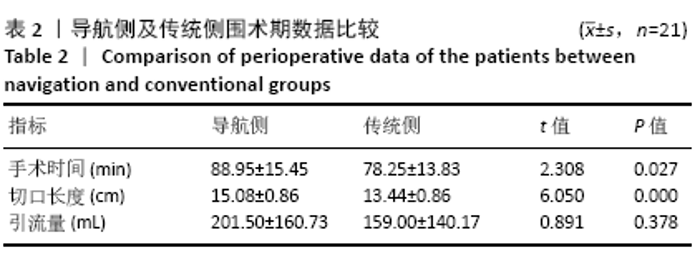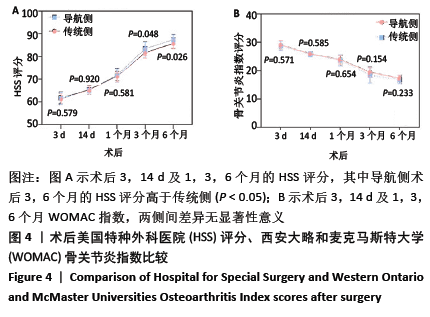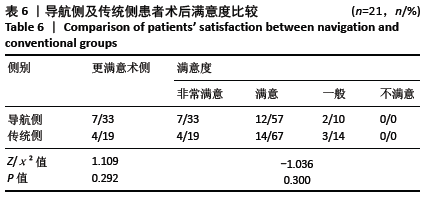Chinese Journal of Tissue Engineering Research ›› 2021, Vol. 25 ›› Issue (21): 3305-3312.doi: 10.3969/j.issn.2095-4344.3866
Previous Articles Next Articles
Computer-navigated versus conventional one-stage bilateral total knee arthroplasty
Zheng Kai, Li Rongqun, Sun Houyi, Zhang Weicheng, Li Ning, Zhou Jun, Zhu Feng, Wang Yijun, Xu Yaozeng
- Department of Orthopedics, the First Affiliated Hospital of Soochow University, Suzhou 215006, Jiangsu Province, China
-
Received:2020-08-11Revised:2020-08-12Accepted:2020-10-16Online:2021-07-28Published:2021-01-23 -
Contact:Xu Yaozeng, Chief physician, Professor, Doctoral supervisor, Department of Orthopedics, the First Affiliated Hospital of Soochow University, Suzhou 215006, Jiangsu Province, China -
About author:Zheng Kai, Master candidate, Department of Orthopedics, the First Affiliated Hospital of Soochow University, Suzhou 215006, Jiangsu Province, China
CLC Number:
Cite this article
Zheng Kai, Li Rongqun, Sun Houyi, Zhang Weicheng, Li Ning, Zhou Jun, Zhu Feng, Wang Yijun, Xu Yaozeng. Computer-navigated versus conventional one-stage bilateral total knee arthroplasty[J]. Chinese Journal of Tissue Engineering Research, 2021, 25(21): 3305-3312.
share this article

2.4 影像学结果比较 导航侧和传统侧术后均能获得良好的假体位置(表3),两侧间术后下肢机械轴髋-膝-踝角α、股骨远端机械轴外侧角β、股骨侧假体矢状面角δ、胫骨近端内侧角γ、胫骨后倾角ε、股骨-髌骨角Q、股骨切迹相比差异无显著性意义(P > 0.05);但是导航侧术后目标力线偏倚明显更小(P=0.013)。对于术前下肢力线畸形>15°患者,导航侧能够获得更准确的下肢力线(P=0.021);而在术前下肢力线畸形<5°、5°-10°、11°-15°亚组中,两组间差异无显著性意义(P > 0.05);导航侧在<5°、11°-15°、>15°亚组中目标力线偏倚显著减小(P=0.049,0.013,0.036),见表4。 "


2.5 功能结果比较 导航侧与传统侧均能获得较好的功能结果(表5),两侧间术前与末次随访HSS评分、WOMAC指数、FJS-12膝关节遗忘指数差异无显著性意义(P > 0.05);但是导航侧术后3个月HSS评分(83.40±3.02)分高于传统侧(81.65±2.37)分(P=0.048< 0.05),术后6个月HSS评分(87.35± 2.28)分高于传统侧(85.70±2.23)分(P=0.026< 0.05);其余随访时间两侧HSS评分、WOMAC指数差异无显著性意义(图4)。7例患者更满意导航侧术后膝关节,4例患者对传统侧更满意,10例患者认为两侧膝关节无差异;两侧间术后患者满意度差异无显著性意义(P > 0.05),见表6。 "


2.6 并发症情况比较 传统侧有6膝、导航侧有4膝发现下肢深静脉血栓,多为肌间静脉血栓,予常规抗凝治疗好转。导航侧有1膝术后27 d因创伤导致股骨髁上骨折,予切开复位钢板内固定术,目前恢复可。有1例患者术后发生急性脑梗死,目前恢复良好,右侧上、下肢肌力Ⅴ级,Brunnstrom评分:右上肢Ⅵ级-右手Ⅵ级-右下肢Ⅵ级。随访期间,所有患者均未发生膝关节感染、假体松动、脱位和血管神经损伤等并发症。 2.7 典型病例 典型病例1:女性患者,58岁,双膝终末期骨性关节炎,左膝行导航辅助下全膝关节置换,右膝行传统全膝关节置换。术前EOS?双下肢站立位全长X射线片显示双侧膝外翻,术后外翻矫正,力线满意(图5A)。术前双侧膝关节正侧位X射线片示骨赘、游离体明显(图5B);术后双侧膝关节正侧位X射线片示两侧假体位置良好,均无股骨切迹发生(图5C)。 "

| [1] INSALL JN, BINAZZI R, SOUDRY M, et al. Total knee arthroplasty. Clin Orthop Relat Res. 1985;192:13-22. [2] WENG YJ, HSU RW, HSU WH. Comparison of computer-assisted navigation and conventional instrumentation for bilateral total knee arthroplasty. J Arthroplasty. 2009;24(5):668-673. [3] HUANG TW, HSU WH, PENG KT, et al. Total knee arthroplasty with use of computer-assisted navigation compared with conventional guiding systems in the same patient: radiographic results in Asian patients. J Bone Joint Surg Am. 2011;93(13):1197-1202. [4] ZHANG GQ, CHEN JY, CHAI W, et al. Comparison between computer-assisted-navigation and conventional total knee arthroplasties in patients undergoing simultaneous bilateral procedures: a randomized clinical trial. J Bone Joint Surg Am. 2011;93(13):1190-1196. [5] STOCKL B, NOGLER M, ROSIEK R, et al. Navigation improves accuracy of rotational alignment in total knee arthroplasty. Clin Orthop Relat Res. 2004;426:180-186. [6] DE STEIGER RN, LIU YL, GRAVES SE. Computer navigation for total knee arthroplasty reduces revision rate for patients less than sixty-five years of age. J Bone Joint Surg Am. 2015;97(8):635-642. [7] ALLEN CL, HOOPER GJ, ORAM BJ, et al. Does computer-assisted total knee arthroplasty improve the overall component position and patient function? Int Orthop. 2014;38(2):251-257. [8] KIM YH, PARK JW, KIM JS. The Clinical Outcome of Computer-Navigated Compared with Conventional Knee Arthroplasty in the Same Patients: A Prospective, Randomized, Double-Blind, Long-Term Study. J Bone Joint Surg Am. 2017;99(12):989-996. [9] KIM YH, PARK JW, KIM JS. Computer-navigated versus conventional total knee arthroplasty a prospective randomized trial. J Bone Joint Surg Am. 2012;94(22):2017-2024. [10] BAUWENS K, MATTHES G, WICH M, et al. Navigated total knee replacement. A meta-analysis. J Bone Joint Surg Am. 2007;89(2): 261-269. [11] 周宗科, 翁习生, 曲铁兵, 等. 中国髋、膝关节置换术加速康复--围术期管理策略专家共识 [J]. 中华骨与关节外科杂志,2016,9(1): 10-15. [12] MELHEM E, ASSI A, EL RACHKIDI R, et al. EOS((R)) biplanar X-ray imaging: concept, developments, benefits, and limitations. J Child Orthop. 2016;10(1):1-14. [13] PARRATTE S, PAGNANO MW, TROUSDALE RT, et al. Effect of postoperative mechanical axis alignment on the fifteen-year survival of modern, cemented total knee replacements . J Bone Joint Surg Am. 2010;92(12):2143-2149. [14] KIM YH, PARK JW, KIM JS, et al. The relationship between the survival of total knee arthroplasty and postoperative coronal, sagittal and rotational alignment of knee prosthesis. Int Orthop. 2014;38(2): 379-385. [15] PITTA M, ESPOSITO CI, LI Z, et al. Failure After Modern Total Knee Arthroplasty: A Prospective Study of 18,065 Knees. J Arthroplasty. 2018;33(2):407-414. [16] RHEE SJ, KIM HJ, LEE CR, et al. A Comparison of Long-Term Outcomes of Computer-Navigated and Conventional Total Knee Arthroplasty: A Meta-Analysis of Randomized Controlled Trials. J Bone Joint Surg Am. 2019;101(20):1875-1885. [17] ARBAB D, REIMANN P, BRUCKER M, et al. Alignment in total knee arthroplasty - A comparison of patient-specific implants with the conventional technique. Knee. 2018;25(5):882-887. [18] AUSTRALIAN ORTHOPAEDIC ASSOCIATION NATIONAL JOINT REPLACEMENT REGISTRY (AOANJRR). Hip, Knee & Shoulder Arthroplasty: 2019 Annual Report. Adelaide: AOA, 2019. [19] CHOONG PF, DOWSEY MM, STONEY JD. Does accurate anatomical alignment result in better function and quality of life? Comparing conventional and computer-assisted total knee arthroplasty. J Arthroplasty. 2009;24(4):560-569. [20] HERNANDEZ-VAQUERO D, SUAREZ-VAZQUEZ A, IGLESIAS-FERNANDEZ S. Can computer assistance improve the clinical and functional scores in total knee arthroplasty? Clin Orthop Relat Res. 2011;469(12): 3436-3442. [21] BEREND ME, RITTER MA, MEDING JB, et al. Tibial component failure mechanisms in total knee arthroplasty. Clin Orthop Relat Res. 2004; 428:26-34. [22] RITTER MA, DAVIS KE, MEDING JB, et al. The effect of alignment and BMI on failure of total knee replacement. J Bone Joint Surg Am. 2011;93(17):1588-1596. [23] INNOCENTI B, BELLEMANS J, CATANI F. Deviations From Optimal Alignment in TKA: Is There a Biomechanical Difference Between Femoral or Tibial Component Alignment? J Arthroplasty. 2016;31(1): 295-301. [24] SLEVIN O, HIRSCHMANN A, SCHIAPPARELLI FF, et al. Neutral alignment leads to higher knee society scores after total knee arthroplasty in preoperatively non-varus patients: a prospective clinical study using 3D-CT . Knee Surg Sports Traumatol Arthrosc. 2018;26(6):1602-1609. [25] BONNER TJ, EARDLEY WG, PATTERSON P, et al. The effect of post-operative mechanical axis alignment on the survival of primary total knee replacements after a follow-up of 15 years . J Bone Joint Surg Br. 2011;93(9):1217-1222. [26] MORGAN SS, BONSHAHI A, PRADHAN N, et al. The influence of postoperative coronal alignment on revision surgery in total knee arthroplasty. Int Orthop. 2008;32(5):639-642. [27] VANLOMMEL L, VANLOMMEL J, CLAES S, et al. Slight undercorrection following total knee arthroplasty results in superior clinical outcomes in varus knees. Knee Surg Sports Traumatol Arthrosc. 2013;21(10): 2325-2330. [28] BELLEMANS J, COLYN W, VANDENNEUCKER H, et al. The Chitranjan Ranawat award: is neutral mechanical alignment normal for all patients? The concept of constitutional varus. Clin Orthop Relat Res. 2012;470(1):45-53. [29] HOWELL SM, HOWELL SJ, KUZNIK KT, et al. Does a kinematically aligned total knee arthroplasty restore function without failure regardless of alignment category? Clin Orthop Relat Res. 2013;471(3):1000-1007. [30] FEHRING TK, MASON JB, MOSKAL J, et al. When computer-assisted knee replacement is the best alternative. Clin Orthop Relat Res. 2006; 452:132-136. [31] DEMIR B, OZKUL B, SAYGILI MS, et al. Deformity correction with total knee arthroplasty for severe knee osteoarthritis accompanying extra-articular femoral deformity: the results are promising . Knee Surg Sports Traumatol Arthrosc. 2018;26(11):3444-3451. [32] MATASSI F, COZZI LEPRI A, INNOCENTI M, et al. Total Knee Arthroplasty in Patients With Extra-Articular Deformity: Restoration of Mechanical Alignment Using Accelerometer-Based Navigation System. J Arthroplasty. 2019;34(4):676-681. [33] DATTANI R, PATNAIK S, KANTAK A, et al. Navigation knee replacement. Int Orthop. 2009;33(1):7-10. [34] 李晓辉, 于建华, 龚跃昆, 等. 导航辅助全膝关节置换与传统置换技术早期临床及 X 线评估 [J]. 中华医学杂志,2015,95(15):1162-1167. [35] WEBER KL, JEVSEVAR DS, MCGRORY BJ. AAOS Clinical Practice Guideline: Surgical Management of Osteoarthritis of the Knee: Evidence-based Guideline. J Am Acad Orthop Surg. 2016;24(8):e94-96. [36] SIU KK, WU KT, KO JY, et al. Effects of computer-assisted navigation versus the conventional technique for total knee arthroplasty on levels of plasma thrombotic markers: a prospective study. Biomed Eng Online. 2019;18(1):99. [37] JUNG HJ, JUNG YB, SONG KS, et al. Fractures associated with computer-navigated total knee arthroplasty. A report of two cases. J Bone Joint Surg Am. 2007;89(10):2280-2284. |
| [1] | Li Dadi, Zhu Liang, Zheng Li, Zhao Fengchao. Correlation of total knee arthroplasty efficacy with satisfaction and personality characteristics [J]. Chinese Journal of Tissue Engineering Research, 2021, 25(9): 1346-1350. |
| [2] | Wei Wei, Li Jian, Huang Linhai, Lan Mindong, Lu Xianwei, Huang Shaodong. Factors affecting fall fear in the first movement of elderly patients after total knee or hip arthroplasty [J]. Chinese Journal of Tissue Engineering Research, 2021, 25(9): 1351-1355. |
| [3] | Wang Jinjun, Deng Zengfa, Liu Kang, He Zhiyong, Yu Xinping, Liang Jianji, Li Chen, Guo Zhouyang. Hemostatic effect and safety of intravenous drip of tranexamic acid combined with topical application of cocktail containing tranexamic acid in total knee arthroplasty [J]. Chinese Journal of Tissue Engineering Research, 2021, 25(9): 1356-1361. |
| [4] | Xiao Guoqing, Liu Xuanze, Yan Yuhao, Zhong Xihong. Influencing factors of knee flexion limitation after total knee arthroplasty with posterior stabilized prostheses [J]. Chinese Journal of Tissue Engineering Research, 2021, 25(9): 1362-1367. |
| [5] | Peng Zhihao, Feng Zongquan, Zou Yonggen, Niu Guoqing, Wu Feng. Relationship of lower limb force line and the progression of lateral compartment arthritis after unicompartmental knee arthroplasty with mobile bearing [J]. Chinese Journal of Tissue Engineering Research, 2021, 25(9): 1368-1374. |
| [6] | Huang Zexiao, Yang Mei, Lin Shiwei, He Heyu. Correlation between the level of serum n-3 polyunsaturated fatty acids and quadriceps weakness in the early stage after total knee arthroplasty [J]. Chinese Journal of Tissue Engineering Research, 2021, 25(9): 1375-1380. |
| [7] | Zhang Chong, Liu Zhiang, Yao Shuaihui, Gao Junsheng, Jiang Yan, Zhang Lu. Safety and effectiveness of topical application of tranexamic acid to reduce drainage of elderly femoral neck fractures after total hip arthroplasty [J]. Chinese Journal of Tissue Engineering Research, 2021, 25(9): 1381-1386. |
| [8] | Chen Junming, Yue Chen, He Peilin, Zhang Juntao, Sun Moyuan, Liu Youwen. Hip arthroplasty versus proximal femoral nail antirotation for intertrochanteric fractures in older adults: a meta-analysis [J]. Chinese Journal of Tissue Engineering Research, 2021, 25(9): 1452-1457. |
| [9] | Huang Dengcheng, Wang Zhike, Cao Xuewei. Comparison of the short-term efficacy of extracorporeal shock wave therapy for middle-aged and elderly knee osteoarthritis: a meta-analysis [J]. Chinese Journal of Tissue Engineering Research, 2021, 25(9): 1471-1476. |
| [10] | Liu Xiangxiang, Huang Yunmei, Chen Wenlie, Lin Ruhui, Lu Xiaodong, Li Zuanfang, Xu Yaye, Huang Meiya, Li Xihai. Ultrastructural changes of the white zone cells of the meniscus in a rat model of early osteoarthritis [J]. Chinese Journal of Tissue Engineering Research, 2021, 25(8): 1237-1242. |
| [11] | Zhong Hehe, Sun Pengpeng, Sang Peng, Wu Shuhong, Liu Yi. Evaluation of knee stability after simulated reconstruction of the core ligament of the posterolateral complex [J]. Chinese Journal of Tissue Engineering Research, 2021, 25(6): 821-825. |
| [12] | Zhao Zhongyi, Li Yongzhen, Chen Feng, Ji Aiyu. Comparison of total knee arthroplasty and unicompartmental knee arthroplasty in treatment of traumatic osteoarthritis [J]. Chinese Journal of Tissue Engineering Research, 2021, 25(6): 854-859. |
| [13] | Liu Shaohua, Zhou Guanming, Chen Xicong, Xiao Keming, Cai Jian, Liu Xiaofang. Influence of anterior cruciate ligament defect on the mid-term outcome of fixed-bearing unicompartmental knee arthroplasty [J]. Chinese Journal of Tissue Engineering Research, 2021, 25(6): 860-865. |
| [14] | Zhang Nianjun, Chen Ru. Analgesic effect of cocktail therapy combined with femoral nerve block on total knee arthroplasty [J]. Chinese Journal of Tissue Engineering Research, 2021, 25(6): 866-872. |
| [15] | Yuan Jun, Yang Jiafu. Hemostatic effect of topical tranexamic acid infiltration in cementless total knee arthroplasty [J]. Chinese Journal of Tissue Engineering Research, 2021, 25(6): 873-877. |
| Viewed | ||||||
|
Full text |
|
|||||
|
Abstract |
|
|||||













